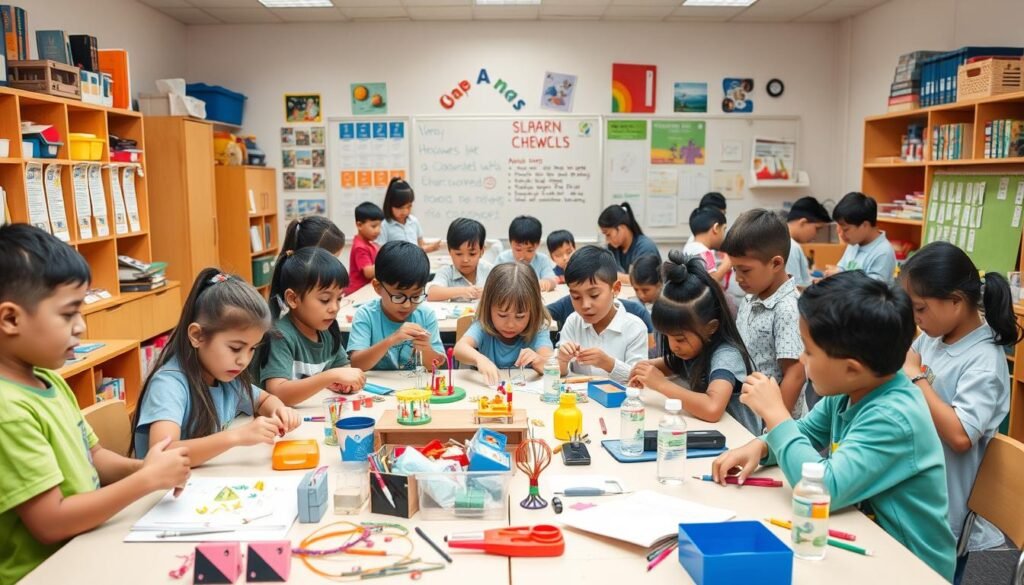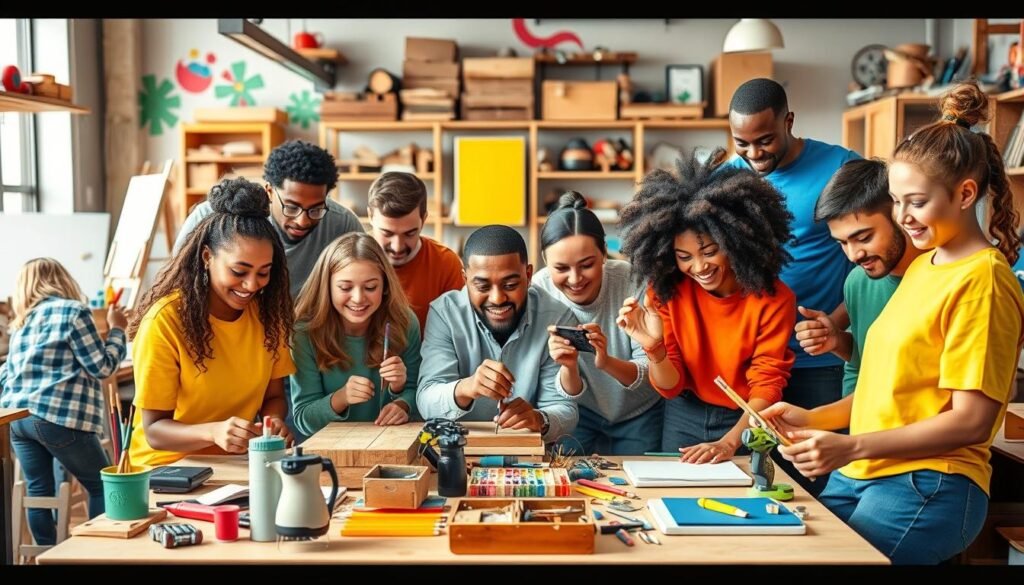Do you remember the excitement of building your first Lego castle or making a handmade gift? Those moments were not just fun; they were powerful learning experiences. Hands-on projects bring back that magic, turning abstract ideas into real skills you can see and use.
In today’s fast world, practical assignments and project-based learning are key. They connect theory with real life, giving you the skills to face challenges directly. Hands-on projects are great for students, professionals, or anyone wanting to learn more. They offer a unique way to master skills that books can’t.
Studies show that learning by doing works wonders. The National Training Laboratories found we keep 75% of what we learn from practice. And that goes up to 90% when we teach or use the skill right away. It’s no surprise that project-based learning is becoming popular in schools and workplaces.
Are you ready to get hands-on and improve your skills? Let’s see how these practical experiences can boost your skill development and open new doors for you.
Key Takeaways
- Hands-on projects boost retention rates to 75-90%
- Project-based learning enhances motivation and real-world problem-solving
- Practical assignments foster critical thinking and tangible outcomes
- Hands-on learning improves social skills and engagement
- Experiential activities lead to quicker knowledge retention
- Interactive learning is more effective for adult learners
Understanding the Power of Hands-on Learning
Hands-on learning changes education for the better. It makes learning active and connects it to real life. This way, you learn by doing, not just listening.
Definition and Importance of Hands-on Learning
Hands-on learning means learning by doing. It’s about getting involved with what you’re learning. This method is key today because it teaches you skills you can use right away.
Charles Jennings’ 70:20:10 model shows that 70% of learning comes from doing things yourself. This proves how important hands-on learning is for gaining skills.
Benefits of Learning by Doing
Learning by doing has many benefits:
- Increased knowledge retention and transfer
- Enhanced problem-solving abilities and critical thinking skills
- Improved focus and attention span, especially for ADHD learners
- Boosted confidence through successful completion of practical tasks
- Greater motivation and enjoyment in the learning process
Hands-on vs. Traditional Learning Methods
Hands-on learning beats traditional lectures in many ways:
| Hands-on Learning | Traditional Learning |
|---|---|
| Interactive and engaging | Often passive |
| Promotes experimentation | Limited practical application |
| Immediate feedback | Delayed feedback |
| Caters to various learning styles | One-size-fits-all approach |
Hands-on learning gives you real-world experience. It makes learning fun and prepares you for challenges ahead. This approach also gives you skills that matter for your career.
The Science Behind Hands-on Learning Effectiveness
Studies prove that hands-on learning is powerful. Students who do interactive exercises do better on tests and are more likely to stay in school. When they recall hands-on experiences, their brains show more activity in areas for senses and movement.
Immersive projects really work. 81% of high school dropouts say real-world learning would have kept them in school. Hands-on science activities give students direct experience with scientific methods. This makes them more engaged and understanding.

Hands-on learning helps with critical thinking and supports students who find learning hard. It makes both sides of the brain work together, helping students remember more. This method also helps with teamwork and solving problems, skills needed in real life.
| Traditional Learning | Hands-on Learning |
|---|---|
| Passive listening | Active engagement |
| Lower retention rates | Higher retention rates |
| Limited sensory input | Multi-sensory experience |
| Abstract concepts | Tangible results |
By using interactive exercises and immersive projects, teachers can make learning better for students. This method boosts grades and builds a love for learning. It also gets students ready for future jobs.
Key Elements of Successful Hands-on Projects
Successful hands-on projects mix real-world tasks with interactive exercises. This blend helps you develop applied skills. Let’s look at what makes these projects great for learning.
Practical, Real-world Tasks
Hands-on projects work best when they reflect everyday jobs. By facing real challenges, you get hands-on experience that helps in your career. This method shows you how your learning applies to real life, making it more engaging.
Simulation Exercises
Simulation exercises offer safe spaces to practice and learn. These setups let you try out skills without the risk of real-world consequences. You can make mistakes, learn from them, and improve in a supportive environment.
Technology Integration
Adding technology to hands-on learning makes it better. Digital tools create immersive training, like virtual labs or IT setups. These tech-based exercises help you learn skills in a modern setting.
| Element | Benefit | Example |
|---|---|---|
| Real-world Tasks | Career Relevance | Designing a Marketing Campaign |
| Simulation Exercises | Risk-free Practice | Flight Simulator Training |
| Technology Integration | Immersive Learning | Virtual Reality Surgical Training |
By combining these elements, hands-on projects offer powerful learning experiences. You’ll gain applied skills through real-world tasks and interactive exercises. This prepares you for success in your field.
Enhancing Skill Retention Through Interactive Experiences
Interactive experiences change the game in skill retention. They make learners more active, which boosts understanding and retention way more than just listening. Let’s see how these dynamic ways change how we learn and keep skills.

Hands-on activities like simulations and role-playing work really well. Over 80% of learners like these methods a lot. They make learning fun and increase confidence and motivation.
Interactive exercises use different learning principles to help us remember better:
- Active engagement
- Relevance to learner interests
- Repeated practice
- Breaking information into manageable chunks
- Regular retrieval of information
- Multi-modal approaches
These strategies really make a difference. A study showed that computer games and interactive simulations lead to better thinking skills than old-school methods in many areas.
| Learning Method | Retention Rate | Engagement Level |
|---|---|---|
| Passive Lectures | Low | Low |
| Interactive Exercises | High | High |
| Hands-on Activities | Very High | Very High |
Adding these interactive parts to your learning makes you more than just remember facts. You’re experiencing them. This way, you get a deep understanding, keep improving skills, and feel more confident in using what you know.
Hands-on Projects for Professional Development
Project-based learning is a great way to grow your skills. By working on real projects, you can learn skills that matter in your job.
Industry-specific Project Ideas
Jump into projects that reflect real-world challenges in your field. Marketing pros can start a campaign. Product designers can work on a new prototype. These tasks let you use what you’ve learned in practical ways, just like teachers do in their classrooms.
Learn more about applying learningin real
Cross-functional Skill Development
Try projects that push you to learn new things across different areas. For instance, a workshop on visual thinking can improve problem-solving by 24%. Leadership programs, lasting six months, help grow potential and make teams work better together.
Portfolio-building Opportunities
Every project you finish adds to your professional skills. Build a portfolio to show off your skills and successes. This portfolio can be a strong asset when you’re looking for new chances or moving up in your career.
- Time management projects to boost productivity
- Communication workshops to enhance teamwork
- Conflict resolution training for better team dynamics
Investing in these hands-on learning experiences helps you grow in your career. Companies that focus on this kind of learning see a 30% increase in keeping employees and a 24% jump in profits.
Implementing Hands-on Projects in Educational Settings
Hands-on projects are changing how we teach. Studies show they make students do better and stay motivated. By adding practical tasks to lessons, teachers make learning fun and memorable.
Experiential learning comes in many ways in school today. Students can do experiments, build models, go on field trips, and solve problems. The goal is to make learning active and useful.
Project-based learning lets students solve real-world problems. It boosts creativity and teamwork and connects different subjects. Even small projects can help students learn a lot, making them understand better.
- Prototyping solutions through mock-ups or role-plays
- Testing ideas to get real feedback
- Generating many ideas during brainstorming
- Using open-ended projects to improve problem-solving
Adding hands-on projects takes time and new teaching methods. Begin with small steps, keep going through tough times, and get advice from others. With effort, you’ll see how valuable experiential learning is.
“Tell me and I forget, teach me and I may remember, involve me and I learn.” – Benjamin Franklin
These ideas work in both in-person and online classes. Online tools and simulations can make hands-on learning available everywhere. Embrace practical assignments and see your students succeed.
Overcoming Challenges in Hands-on Project Implementation
Starting project-based learning and interactive exercises can be tough. You might struggle with not having enough resources, managing your time well, and making projects grow. Let’s look at these problems and find ways to make your hands-on projects work.
Resource Constraints
Not having enough resources can stop your applied skills training. Budget problems can come from bad planning or the economy. Here’s how to deal with it:
- Invest in flexible, scalable digital solutions
- Use free or low-cost online tools for interactive exercises
- Partner with local businesses for real-world project opportunities
Time Management
It’s hard to balance project-based learning with regular work. Here are some tips:
- Choose solutions that allow flexible access to training
- Break large projects into smaller, manageable tasks
- Use time-tracking tools to improve efficiency
Scalability Issues
Scaling hands-on projects for more people can be tough, especially with in-person training. Here’s what you can do:
- Utilize digital platforms that support multiple learners
- Implement peer-to-peer learning to share knowledge
- Create reusable project templates for easy scaling
By tackling these challenges, you can make hands-on learning effective. It helps develop applied skills and keeps learners engaged. The main thing is to be flexible and creative in your project-based learning.
Measuring the Impact of Hands-on Projects on Skill Development
Hands-on projects are key to skill growth. A study looked at how project-based learning helps in junior secondary schools. It had 120 students in two groups, testing their math and science skills.
The study showed big gains in how well students did and how much they took part after using hands-on methods. This proves that doing things hands-on helps in learning. It makes learning more fun and helps students remember more.
Online learning sites like Coursera are growing fast in hands-on learning. They have over 70 million learners worldwide. These sites offer chances to develop skills through coding tasks and peer reviews. This way of learning is great for students who didn’t go to traditional schools.
- 60% of learners report career impact as their primary goal
- Hands-on assessments improve student engagement and satisfaction
- Industry-relevant projects are highly valued by diverse learners
Measuring hands-on projects’ impact means looking at how they improve practical skills, problem-solving, and remembering what was learned. We look at how well students finish real-world tasks, do in simulations, and use what they learned at work. Feedback from students and bosses gives us clues on how well they’re doing and how confident they are.
Innovative Approaches to Hands-on Learning in the Digital Age
The digital era has brought new ways to make hands-on learning exciting. Innovative tools are changing how we do practical assignments and interactive exercises.
Virtual and Augmented Reality Applications
Virtual and augmented reality are changing the game. They let you practice skills in real-life settings safely. You can dissect a virtual frog or explore ancient ruins without leaving class!
Gamification in Hands-on Projects
Gamification makes learning fun. It turns practical assignments into games, keeping you motivated. A study found that students in project-based learning scored 84.6% on average. This was higher than those in traditional lecture groups at 74.2%.
Remote Collaboration Tools
Now, you can work on projects with people from all over the world. These digital platforms let you share ideas and solve problems together. This prepares you for the global workplace of tomorrow.
“Digital learning enhances student engagement and motivation through interactive multimedia content, gamified elements, and virtual simulations.”
These new approaches are making hands-on learning more accessible and effective. By using these tools, you’re not just learning. You’re getting ready for success in the digital age.
Hands-on Projects for Soft Skill Enhancement
Boost your career with hands-on projects that improve essential soft skills. These activities are fun and engaging, helping you develop important skills for the workplace. Let’s look at some project ideas that focus on communication, teamwork, and problem-solving.
Role-playing exercises are perfect for improving communication skills. Try the “Back-to-Back Drawing” game where partners describe and draw objects without seeing each other. This activity helps build clear communication and active listening.
For teamwork, try the “Teamwork Cup Stack” challenge. Teams must build a pyramid of cups using only string and rubber bands. This activity promotes cooperation, patience, and negotiation skills.
Problem-solving skills get a boost with activities like “Lost at Sea.” Teams rank items for survival on a deserted island. This encourages decision-making and persuasion skills.
- Leadership: Organize a mini-hackathon or design thinking workshop
- Creativity: Try “Crazy Comics” – teams collaboratively create stories panel-by-panel
- Adaptability: Play “Emotional Charades” to practice non-verbal communication
These projects offer practical experiences in real-life scenarios. By taking part in these activities, you’ll improve the soft skills employers look for. Remember, the more you practice, the better you’ll get. The key is to keep participating in these hands-on learning experiences.
Customizing Hands-on Projects for Different Learning Styles
Making hands-on projects fit different learning styles can really help improve skills. By using interactive exercises and practical tasks, you can make learning fun for everyone. This way, you help visual, auditory, and kinesthetic learners all at once.
Visual Learners
Visual learners do well with diagrams, charts, and images. Add these to your projects to help them understand complex ideas better. Tools like infographics or virtual reality can make learning stick.
Auditory Learners
Auditory learners love to hear and talk about what they’re learning. Add group talks, debates, and presentations to your projects. Podcasts or audio guides can also make learning fun for them. This way, they can really get the ideas to stick.
Kinesthetic Learners
Kinesthetic learners need to move and touch things to learn. Make your projects hands-on, like building or acting out scenarios. For example, the Spark-Y program at Crossroads Elementary uses engineering classes to solve real classroom problems. This not only keeps kinesthetic learners engaged but also boosts problem-solving for everyone.


